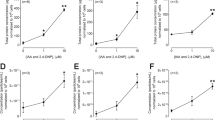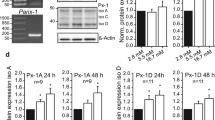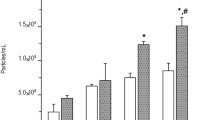Abstract
Exosomes, small-sized extracellular vesicles, carry components of the purinergic pathway. The production by cells of exosomes carrying this pathway remains poorly understood. Here, we asked whether type 1, 2A, or 2B adenosine receptors (A1Rs, A2ARs, and A2BRs, respectively) expressed by producer cells are involved in regulating exosome production. Preglomerular vascular smooth muscle cells (PGVSMCs) were isolated from wildtype, A1R−/−, A2AR−/−, and A2BR−/− rats, and exosome production was quantified under normal or metabolic stress conditions. Exosome production was also measured in various cancer cells treated with pharmacologic agonists/antagonists of A1Rs, A2ARs, and A2BRs in the presence or absence of metabolic stress or cisplatin. Functional activity of exosomes was determined in Jurkat cell apoptosis assays. In PGVSMCs, A1R and A2AR constrained exosome production under normal conditions (p = 0.0297; p = 0.0409, respectively), and A1R, A2AR, and A2BR constrained exosome production under metabolic stress conditions. Exosome production from cancer cells was reduced (p = 0.0028) by the selective A2AR agonist CGS 21680. These exosomes induced higher levels of Jurkat apoptosis than exosomes from untreated cells or cells treated with A1R and A2BR agonists (p = 0.0474). The selective A2AR antagonist SCH 442416 stimulated exosome production under metabolic stress or cisplatin treatment, whereas the selective A2BR antagonist MRS 1754 reduced exosome production. Our findings indicate that A2ARs suppress exosome release in all cell types examined, whereas effects of A1Rs and A2BRs are dependent on cell type and conditions. Pharmacologic targeting of cancer with A2AR antagonists may inadvertently increase exosome production from tumor cells.





Similar content being viewed by others
References
Kucharzewska P, Christianson HC, Welch JE, Svensson KJ, Fredlund E, Ringner M, Morgelin M, Bourseau-Guilmain E, Bengzon J, Belting M (2013) Exosomes reflect the hypoxic status of glioma cells and mediate hypoxia-dependent activation of vascular cells during tumor development. Proc Natl Acad Sci U S A 110:7312–7317
Whiteside TL (2016) The potential of tumor-derived exosomes for noninvasive cancer monitoring. Expert Rev Mol Diagn 15:1293–1310
Whiteside TL (2016) Tumor-derived exosomes and their role in cancer progression. Adv Clin Chem 74:103–141
Mulcahy LA, Pink RC, Carter DRF (2014) Routes and mechanisms of extracellular vesicle uptake. J Extracell Vesicles 3:1–14
Clayton A, Al-Taei S, Webber J et al (2011) Cancer exosomes express CD39 and CD73, which suppress T cells through adenosine production. J Immunol 187:676–683
Ludwig N, Yerneni SS, Razzo BM, Whiteside TL (2018) Exosomes from HNSCC promote angiogenesis through reprogramming of endothelial cells. Mol Cancer Res 16:1798–1808
Ludwig N, Whiteside TL (2018) Potential roles of tumor-derived exosomes in angiogenesis. Expert Opin Ther Targets 22:409–417
Webber J, Steadman R, Mason MD, Tabi Z, Clayton A (2010) Cancer exosomes trigger fibroblast to myofibroblast differentiation. Cancer Res 70:9621–9631
Peinado H, Alečković M, Lavotshkin S, Matei I, Costa-Silva B, Moreno-Bueno G, Hergueta-Redondo M, Williams C, García-Santos G, Ghajar CM, Nitadori-Hoshino A, Hoffman C, Badal K, Garcia BA, Callahan MK, Yuan J, Martins VR, Skog J, Kaplan RN, Brady MS, Wolchok JD, Chapman PB, Kang Y, Bromberg J, Lyden D (2012) Melanoma exosomes educate bone marrow progenitor cells toward a pro-metastatic phenotype through MET. Nat Med 18:883–891
Razzo BM, Ludwig N, Hong C, et al (2019) Tumor-derived exosomes promote carcinogenesis of murine oral squamous cell carcinoma. Carcinogenesis 1–9
Abels ER, Breakefield XO (2016) Introduction to extracellular vesicles: biogenesis, RNA cargo selection, content, release, and uptake. Cell Mol Neurobiol 36:301–312
Rak J (2013) Extracellular vesicles - biomarkers and effectors of the cellular interactome in cancer. Front Pharmacol 4:1–14
Urbanelli L, Magini A, Buratta S, Brozzi A, Sagini K, Polchi A, Tancini B, Emiliani C (2013) Signaling pathways in exosomes biogenesis, secretion and fate. Genes (Basel) 4:152–170
Schuler PJ, Saze Z, Hong C-S, Muller L, Gillespie DG, Cheng D, Harasymczuk M, Mandapathil M, Lang S, Jackson EK, Whiteside TL (2014) Human CD4+ CD39+ regulatory T cells produce adenosine upon co-expression of surface CD73 or contact with CD73+ exosomes or CD73+ cells. Clin Exp Immunol 177:531–543
Jacobson KA, Gao ZG (2006) Adenosine receptors as therapeutic targets. Nat Rev Drug Discov 5:247–264
Marincola FM, Shamamian P, Simonis TB, Abati A, Hackett J, O’Dea T, Fetsch P, Yannelli J, Restifo NP, Mule JJ, Rosenberg SA (1994) Locus-specific analysis of human leukocyte antigen class I expression in melanoma cell lines. J Immunother Emphas Tumor Immunol 16:13–23
Zhu X, Jackson EK (2017) RACK1 regulates angiotensin II-induced contractions of SHR preglomerular vascular smooth muscle cells. Am J Physiol Ren Physiol 312:F565–F576
Jackson EK, Gillespie DG, Mi Z, Cheng D (2018) Adenosine receptors influence hypertension in dahl salt-sensitive rats: dependence on receptor subtype, salt diet, and sex. Hypertension 72:511–521
Ludwig N, Razzo BM, Yerneni SS, Whiteside TL (2019) Optimization of cell culture conditions for exosome isolation using mini-size exclusion chromatography (mini-SEC). Exp Cell Res 378:149–157
Ludwig N, Hong C-S, Ludwig S et al (2019) Isolation and analysis of tumor-derived exosomes. Curr Protoc Immunol 127:e91
Hong C-S, Funk S, Muller L, Boyiadzis M, Whiteside TL (2016) Isolation of biologically active and morphologically intact exosomes from plasma of patients with cancer. J Extracell Vesicles 5:29289
Théry C, Witwer KW, Aikawa E et al (2019) Minimal information for studies of extracellular vesicles 2018 (MISEV2018): a position statement of the International Society for Extracellular Vesicles and update of the MISEV2014 guidelines. J Extracell Vesicles 8:1535750
Jackson TC, Kotermanski SE, Kochanek PM, Jackson EK (2019) Oxidative stress induces release of 2 ’ -AMP from microglia. Brain Res 1706:101–109
Ludwig N, Yerneni SS, Menshikova EV et al (2020) Simultaneous inhibition of glycolysis and oxidative phosphorylation triggers a multi-fold increase in secretion of exosomes: possible role of 2′3′-cAMP. Sci Rep 10:6948
Jackson EK, Cheng D, Mi Z, Gillespie DG (2014) Guanosine regulates adenosine levels in the kidney. Physiol Rep 2:1–9
Yan A, Joachims ML, Thompson LF, Miller AD, Canoll PD, Bynoe MS (2019) CD73 promotes glioblastoma pathogenesis and enhances its chemoresistance via A2B adenosine receptor signaling. J Neurosci 39:4387–4402
Fernandez-Gallardo M, González-Ramírez R, Sandoval A et al (2016) Adenosine stimulate proliferation and migration in triple negative breast cancer cells. PLoS One 11:1–14
Ludwig N, Whiteside TL, Reichert TE (2019) Challenges in exosome isolation and analysis in health and disease. Int J Mol Sci 20:4684
Chen T, Guo J, Yang M, Zhu X, Cao X (2011) Chemokine-containing exosomes are released from heat-stressed tumor cells via lipid raft-dependent pathway and act as efficient tumor vaccine. J Immunol 186:2219–2228
Keklikoglou I, Cianciaruso C, Güç E, Squadrito ML, Spring LM, Tazzyman S, Lambein L, Poissonnier A, Ferraro GB, Baer C, Cassará A, Guichard A, Iruela-Arispe ML, Lewis CE, Coussens LM, Bardia A, Jain RK, Pollard JW, de Palma M (2019) Chemotherapy elicits pro-metastatic extracellular vesicles in breast cancer models. Nat Cell Biol 21:190–202
Garcia NA, Ontoria-Oviedo I, González-King H et al (2015) Glucose starvation in cardiomyocytes enhances exosome secretion and promotes angiogenesis in endothelial cells. PLoS One 10:1–23
Rice GE, Scholz-Romero K, Sweeney E, Peiris H, Kobayashi M, Duncombe G, Mitchell MD, Salomon C (2015) The effect of glucose on the release and bioactivity of exosomes from first trimester trophoblast cells. J Clin Endocrinol Metab 100:E1280–E1288
Lamichhane TN, Leung CA, Douti LY, Jay SM (2017) Ethanol induces enhanced vascularization bioactivity of endothelial cell-derived extracellular vesicles via regulation of microRNAs and long non-coding RNAs. Sci Rep 7:13794
Zhou X, Zhang W, Yao Q, Zhang H, Dong G, Zhang M, Liu Y, Chen JK, Dong Z (2017) Exosome production and its regulation of EGFR during wound healing in renal tubular cells. Am J Physiol Physiol 312:F963–F970
Glebov K, Löchner M, Jabs R, Lau T, Merkel O, Schloss P, Steinhäuser C, Walter J (2015) Serotonin stimulates secretion of exosomes from microglia cells. Glia 63:626–634
Qu Y, Franchi L, Nunez G, Dubyak GR (2007) Nonclassical IL-1 secretion stimulated by P2X7 receptors is dependent on inflammasome activation and correlated with exosome release in murine macrophages. J Immunol 179:1913–1925
Savina A, Furlán M, Vidal M, Colombo MI (2003) Exosome release is regulated by a calcium-dependent mechanism in K562 cells. J Biol Chem 278:20083–20090
Sayner S, Choi C, Maulucci M et al (2019) Extracellular vesicles: another compartment for the second messenger, cyclic adenosine monophosphate (cAMP). Am J Physiol Lung Cell Mol Physiol 316:L691–L700
Leiva A, Guzmán-Gutiérrez E, Contreras-Duarte S, Fuenzalida B, Cantin C, Carvajal L, Salsoso R, Gutiérrez J, Pardo F, Sobrevia L (2017) Adenosine receptors: modulators of lipid availability that are controlled by lipid levels. Mol Asp Med 55:26–44
Adler KB, Tuvim MJ, Dickey BF (2013) Regulated mucin secretion from airway epithelial cells. Front Endocrinol (Lausanne) 4:1–9
Ikeda K, Kurokawa M, Aoyama S, Kuwana Y (2002) Neuroprotection by adenosine A2A receptor blockade in experimental models of Parkinson’s disease. J Neurochem 80:262–270
Whiteside TL (2017) Targeting adenosine in cancer immunotherapy: a review of recent progress. Expert Rev Anticancer Ther 17:527–535
Ma SR, Deng WW, Liu JF et al (2017) Blockade of adenosine A2A receptor enhances CD8+ T cells response and decreases regulatory T cells in head and neck squamous cell carcinoma. Mol Cancer 16:1–15
Wei Q, Costanzi S, Balasubramanian R, Gao ZG, Jacobson KA (2013) A2B adenosine receptor blockade inhibits growth of prostate cancer cells. Purinergic Signal 9:271–280
Funding
N.L. was supported by the Leopoldina Fellowships LPDS 2017-12 and LPDR 2019-02 from German National Academy of Sciences Leopoldina. This work was supported by National Institutes of Health grants HL109002, DK091190, HL069846, DK068575, and DK079307 (to EKJ) and the NIH grant R01-CA 1686288 to TLW.
Author information
Authors and Affiliations
Corresponding author
Ethics declarations
Conflict of interest
The authors declare that they have no conflicts of interest.
Ethical approval
This article does not contain any studies with participants or animals performed by any of the authors.
Additional information
Publisher’s note
Springer Nature remains neutral with regard to jurisdictional claims in published maps and institutional affiliations.
Rights and permissions
About this article
Cite this article
Ludwig, N., Azambuja, J.H., Rao, A. et al. Adenosine receptors regulate exosome production. Purinergic Signalling 16, 231–240 (2020). https://doi.org/10.1007/s11302-020-09700-7
Received:
Accepted:
Published:
Issue Date:
DOI: https://doi.org/10.1007/s11302-020-09700-7




